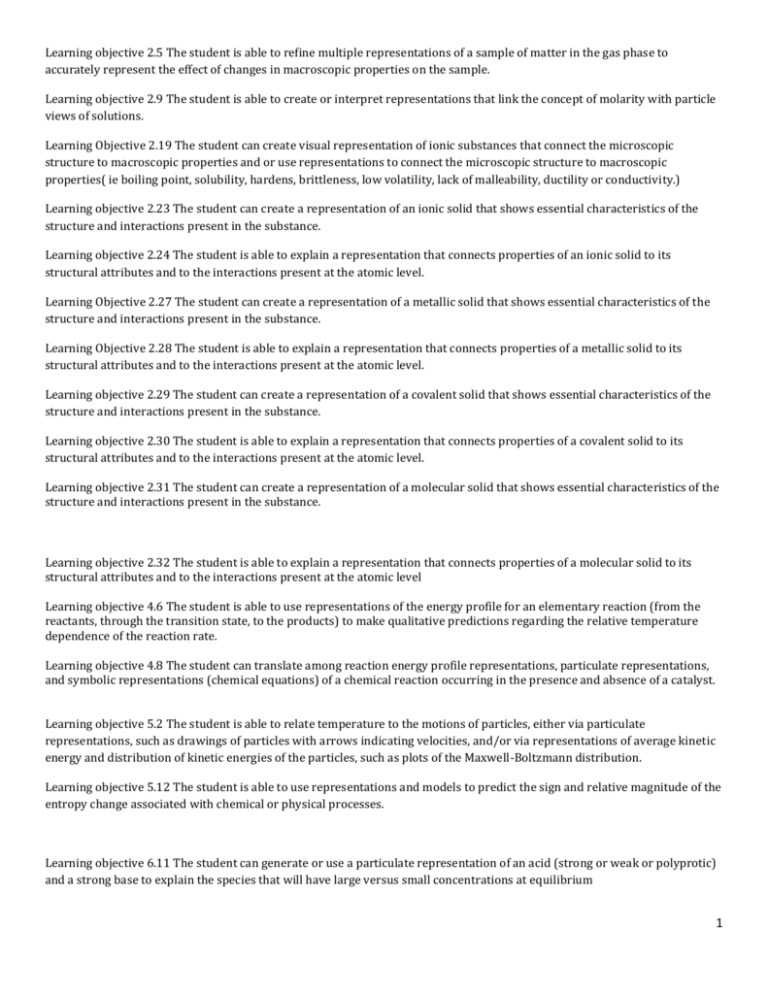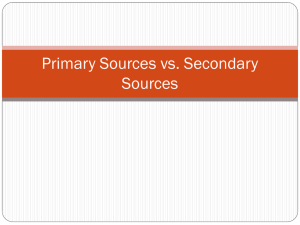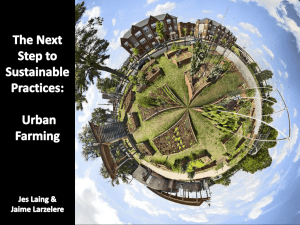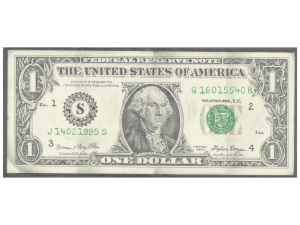Learning objective 2.5 The student is able to refine multiple
advertisement

Learning objective 2.5 The student is able to refine multiple representations of a sample of matter in the gas phase to accurately represent the effect of changes in macroscopic properties on the sample. Learning objective 2.9 The student is able to create or interpret representations that link the concept of molarity with particle views of solutions. Learning Objective 2.19 The student can create visual representation of ionic substances that connect the microscopic structure to macroscopic properties and or use representations to connect the microscopic structure to macroscopic properties( ie boiling point, solubility, hardens, brittleness, low volatility, lack of malleability, ductility or conductivity.) Learning objective 2.23 The student can create a representation of an ionic solid that shows essential characteristics of the structure and interactions present in the substance. Learning objective 2.24 The student is able to explain a representation that connects properties of an ionic solid to its structural attributes and to the interactions present at the atomic level. Learning Objective 2.27 The student can create a representation of a metallic solid that shows essential characteristics of the structure and interactions present in the substance. Learning Objective 2.28 The student is able to explain a representation that connects properties of a metallic solid to its structural attributes and to the interactions present at the atomic level. Learning objective 2.29 The student can create a representation of a covalent solid that shows essential characteristics of the structure and interactions present in the substance. Learning objective 2.30 The student is able to explain a representation that connects properties of a covalent solid to its structural attributes and to the interactions present at the atomic level. Learning objective 2.31 The student can create a representation of a molecular solid that shows essential characteristics of the structure and interactions present in the substance. Learning objective 2.32 The student is able to explain a representation that connects properties of a molecular solid to its structural attributes and to the interactions present at the atomic level Learning objective 4.6 The student is able to use representations of the energy profile for an elementary reaction (from the reactants, through the transition state, to the products) to make qualitative predictions regarding the relative temperature dependence of the reaction rate. Learning objective 4.8 The student can translate among reaction energy profile representations, particulate representations, and symbolic representations (chemical equations) of a chemical reaction occurring in the presence and absence of a catalyst. Learning objective 5.2 The student is able to relate temperature to the motions of particles, either via particulate representations, such as drawings of particles with arrows indicating velocities, and/or via representations of average kinetic energy and distribution of kinetic energies of the particles, such as plots of the Maxwell-Boltzmann distribution. Learning objective 5.12 The student is able to use representations and models to predict the sign and relative magnitude of the entropy change associated with chemical or physical processes. Learning objective 6.11 The student can generate or use a particulate representation of an acid (strong or weak or polyprotic) and a strong base to explain the species that will have large versus small concentrations at equilibrium 1 Your job is to create a magazine that represents all of these concepts. Each concept must be represented by illustrations and a short explanation. The illustrations must be colored. Your magazine needs to contain articles and advertisements. In addition you can include puzzles. All of these must pertain to the above Learning Objectives. Due April 4, 2014 CATEGOR Y Content Accuracy 4 All facts in the Magazine are accurate. 3 99-90% of the facts in the Magazine are accurate. 2 89-80% of the facts in the Magazine are accurate. 1 Fewer than 80% of the facts in the Magazine are accurate. Attractive ness & Organizati on The Magazine has exceptionally attractive formatting and wellorganized information. The Magazine has attractive formatting and well-organized information. The Magazine has well-organized information. The Magazine\'s formatting and organization of material are confusing to the reader. Graphics/ Pictures Graphics go well with the text and there is a good mix of text and graphics. Graphics go well with the text, but there are so many that they distract from the text. Graphics go well with the text, but there are too few and the Magazine seems \"textheavy\". Graphics do not go with the accompanying text or appear to be randomly chosen. 2







